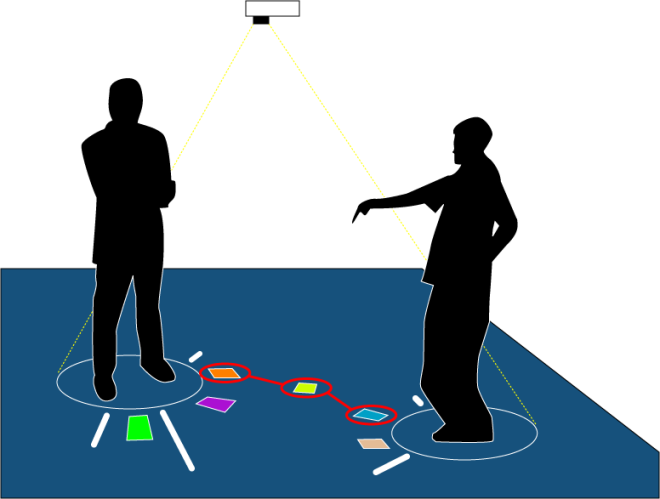In 2008, I collaborated on a project called “Digital Shadow”.
As we go about our daily lives in the physical world, we are increasingly followed by a digital shadow, the record of our online actions and identities. At times we can control the shadow – carefully crafting a personal profile on a social network site, for example, or maintaining a personal homepage or blog. In other contexts, we may be surprised, disturbed, or even put at risk by the breadth and detail of our digital personas.
Our project, Digital Shadow, proposes an interface that could help users explore these issues by extending the metaphor of the digital shadow into the physical world, using an interactive floor projection to display a “shadow” of personal information around users in the interaction space. The interface could be used to facilitate interaction between users in a professional or social setting, where each user had full control over their profile information; we are also interested in a more experimental mode, in which the interface could display an automatically retrieved set of public information from web searches and social network sites, asking users to consider the extent and ramifications of their digital shadow.
User Scenario
Tim is a college student who’s interested in multimedia/art exhibits. He discovers an upcoming digital faire and decides to attend the reception. There is no sign-up or RSVP so Tim just attends.
Upon entering the exhibit, Tim is identified and begins to see information about him, such as web posts, blogs, flickr images, and other digital artifacts projected on the floor around him, following him around the room. As he interacts with other people in this space, he begins to feel slightly ‘exposed’ by the amount of information he is presenting to others. Old flamewars and flickr posts he was involved in from when he was in highschool suddenly appear, and he begins to try and sweep them away with his foot.
Implementation
Our Digital Shadow has 4 main components:
- a method for identifying a participant
- a mechanism for tracking a participant and their gestures
- some form of data-mining/research participants
- a form of visualization
We are currently exploring methods of identifying the users such as
- requiring them to ‘sign up’ to participate
- having an ‘operator’ add a participant when they enter the room
- using a student’s
Once a participant has been ‘identified’, we plan to track their movement in the space using either
- visual tracking in software/Processing using a webcam
- using markers, such as color-specific stickers or LEDs to track a user
- using infra-red cameras to detect objects/distance
The core of the system will consist of an internet enabled computer connected to a projector. This will do all the computation, tracking, data-mining (internet/flickr/etc), and visualization (in Processing).

